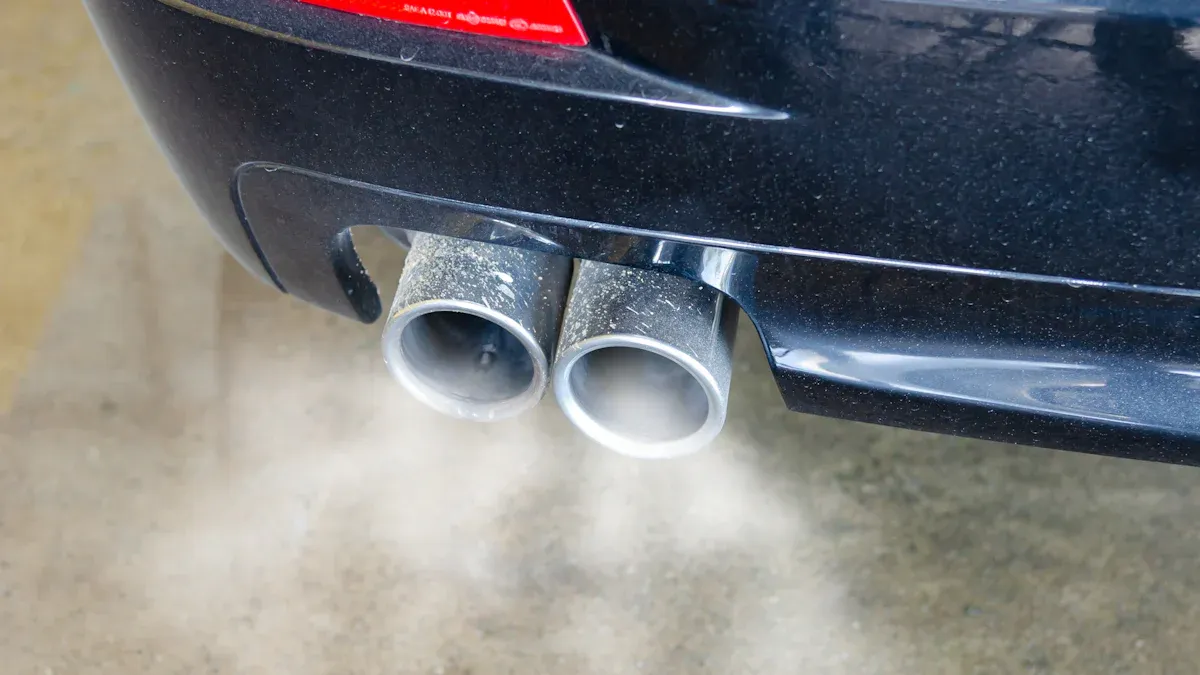close
Choose Your Site
Global
Social Media
Views: 0 Author: Site Editor Publish Time: 2025-09-18 Origin: Site









The check engine light turns on.
Your car can go into limp mode, which lowers power.
You use more fuel.
You might not pass an emissions test.
The Diesel Particulate Filter (DPF) can break if regeneration stops, causing clogs and limp mode.
Fixing the problem quickly saves you money. Our company says you should watch for these warning signs.
A bad Exhaust Gas Temperature Sensor can turn on the check engine light. It can also make your car go into limp mode. This means your car will lose power and not work as well.
If you ignore sensor problems, your car may use more gas. Repairs can get expensive. You might even hurt the Diesel Particulate Filter (DPF) or engine parts.
Look for warning signs like strange smells from the exhaust. Too much smoke or lower gas mileage are also signs. These can help you find sensor problems early.
Doing regular checks and maintenance can help your Exhaust Gas Temperature Sensor last longer. This can stop big problems from happening.
If you see any warning signs, get help from a mechanic fast. This can stop more damage and help you save money on repairs.

You want your car to run well every day. If the Exhaust Gas Temperature Sensor stops working, your engine may act strange. This sensor tells the ECU how hot the exhaust is. If it gives wrong info, the ECU cannot do its job right.
You might see the check engine light come on. Sometimes, your car goes into limp mode. Limp mode makes your engine weaker to keep parts safe. Your car may slow down, and pressing the gas might not help much.
Tip: If your car loses power or shows a warning light, check the Exhaust Gas Temperature Sensor first.
The Exhaust Gas Temperature Sensor also keeps the turbocharger safe. When it works, it keeps exhaust heat at a safe level. If it fails, the ECU may not control turbo boost well. This can make the exhaust too hot. Hot exhaust can hurt the turbocharger and other engine parts. Repairs can cost a lot if you ignore these signs.
A broken Exhaust Gas Temperature Sensor can make your car use more fuel. The sensor helps the ECU know when to clean the DPF. If it sends wrong signals, the ECU may clean the DPF too much. Cleaning uses extra fuel and lowers your miles per gallon.
You may notice:
More stops for gas
Fewer miles per gallon on your dashboard
Strange fuel smells from the exhaust
A bad sensor can start DPF cleaning when it is not needed. These cleanings waste fuel and cost you money over time. You may not see the problem right away, but you will spend more.
Passing an emissions test helps your car and the planet. The Exhaust Gas Temperature Sensor helps your car burn fuel cleaner. If the sensor fails, your car may pollute more. You could fail an emissions test because the engine cannot mix air and fuel right.
The DPF needs the Exhaust Gas Temperature Sensor to work. The DPF catches soot from the exhaust. The sensor tells the ECU when to clean the DPF. If the sensor is broken, the DPF may not clean itself. Soot can block the filter. A blocked DPF can put your car in limp mode. You may see thick smoke or smell burning from the exhaust.
Note: If you ignore a bad Exhaust Gas Temperature Sensor, the DPF can break. Fixing a DPF costs much more than fixing a sensor.
Always watch for changes in how your car runs, uses fuel, or smells. These signs can help you find Exhaust Gas Temperature Sensor problems early.

When your car has a problem with the Exhaust Gas Temperature Sensor, you will notice some clear warning signs. Paying attention to these symptoms helps you catch issues early and avoid bigger repairs.
The check engine light is often the first sign you see. Your car’s computer turns on this light when it finds a problem. If the sensor fails, the system stores a trouble code. You can use a scan tool to read these codes. Here are some common codes linked to this sensor:
DTC Code | Description | Common Causes | Symptoms |
|---|---|---|---|
P2471 | Exhaust Gas Temperature Sensor Circuit High Bank 1 Sensor 4 | Faulty EGT sensor, bad PCM, EGT sensor wiring issues | Check engine light, limp mode |
If you see the check engine light, do not ignore it. A quick scan can tell you if the sensor is the cause.
Limp mode protects your engine when something goes wrong. You will notice your car feels weak and does not respond well when you press the gas. The engine may not rev past a certain point. When the sensor fails, the engine usually limits the RPM to around 6200 RPM. This keeps the engine safe but makes driving harder.
Signs of limp mode:
Slow acceleration
Limited top speed
Engine feels sluggish
If you notice these changes, your car is telling you to check for problems right away.
Changes in your exhaust can also warn you about sensor trouble. Watch for:
Excessive smoke or discolored exhaust can indicate combustion issues.
Strong fuel smells from the tailpipe
Smoke that looks darker or thicker than normal
Unusual exhaust often means your engine is not burning fuel correctly. This can lead to more pollution and damage to other parts.
Spotting these warning signs early helps you fix problems before they get worse. Always pay attention to how your car feels, sounds, and smells.
If you ignore a bad Exhaust Gas Temperature Sensor, your engine can get hurt. When the sensor does not work, your engine may get too hot. Hot engines can break important parts over time. The turbocharger, exhaust manifold, and pistons can all get damaged. These parts must stay cool to work right. If they get too hot, they might crack or break.
Too much heat in the exhaust can cause:
Cracks in the exhaust manifold or turbine housing
Turbocharger damage from getting hot and cold too often
Pistons and other engine parts wearing out too soon
High heat is bad for your engine. If you do not fix the problem, your engine could have big trouble.
The Diesel Particulate Filter (DPF) needs the sensor to clean itself. If the sensor is broken, the DPF may not clean when it should. Soot and diesel particles can fill up the filter. This can block the exhaust and make your engine work harder.
A clogged DPF can cause:
Bad engine performance
Worse gas mileage
Higher engine and transmission heat
More black smoke from the exhaust
The check engine light to turn on
A blocked DPF can even melt or break apart. This can hurt other engine parts and make repairs harder.
If you do not fix the sensor, repairs can get expensive fast. Getting a new DPF can cost about $1,700. If you wait too long, you may also need to fix the turbocharger or pistons. These repairs cost a lot and can keep your car in the shop for days.
Fixing the sensor early saves money and keeps your car working well.
You can find problems with your exhaust sensor by doing some easy checks. First, look at the wires and connectors. See if any are broken or loose. Check for damage on the sensor. Use a scan tool to look for trouble codes. Codes like P0546 or P2429 can mean the sensor is bad. Here is a simple guide:
Check the voltage at the sensor connector. You should see about 5 volts when the ignition is on and the sensor is unplugged.
Use an infrared thermometer to compare the sensor’s reading with the real exhaust pipe temperature.
Look at the sensor, wires, and connectors for damage or rust.
Measure the sensor’s resistance with a digital multimeter. Compare your reading to the numbers in your car’s manual.
Use a diagnostic unit to look for saved error codes and check sensor data.
If you see the check engine light or your car runs badly, scan for codes before you change any parts.
Code | Description | Common Causes |
|---|---|---|
P0546 | Exhaust Gas Temperature Sensor Circuit High | Bad sensor, PCM issues, wiring or connector |
P2429 | Exhaust Gas Temp Too High Bank 2 | Sensor malfunction, possible overheating |
If you find a bad sensor, you can put in a new one with some tools. Here are the main steps:
Find the sensor on the exhaust manifold.
Unplug the electrical connector.
Take out the bolts that hold the sensor.
Put in the new sensor by doing these steps backwards.
Ask a mechanic for help if you do not feel sure. Always use the right part for your car. After you put in the new sensor, clear any trouble codes with your scan tool.
Changing a sensor is usually quicker and costs less than fixing engine or DPF problems later.
You can help your sensor last longer by taking care of your car. Regular checks and service stop sudden problems.
Look at the EGR cooler and sensor wires for damage or leaks.
Watch coolant levels and make sure it is clean to stop overheating.
Check exhaust gas temperatures with your scan tool.
Clean the EGR cooler when you do regular service.
Scan for hidden or new codes every time you service your car.
Change old sensors based on your car’s service history.
Follow the inspection schedule in your owner’s manual.
Doing regular maintenance keeps your Exhaust Gas Temperature Sensor working well and your car running great.
You need to address Exhaust Gas Temperature Sensor issues as soon as you notice them. Early action helps you avoid engine and DPF damage, pass emissions tests, and save money on repairs.
Watch for warning signs like the check engine light or limp mode.
Take your car to a professional if you feel unsure.
Quick attention keeps your vehicle running smoothly and protects your wallet.
The sensor checks how hot your exhaust gases get. It sends this information to your car’s computer. The computer uses this data to keep your engine safe and help control emissions.
You can drive for a short time, but you risk engine damage or DPF problems. Your car may use more fuel and lose power. Fix the sensor as soon as possible.
Most sensors cost between $50 and $200. Labor can add $50 to $150. The total price depends on your car’s make and model.
Yes. A faulty sensor can make your car pollute more. You may fail an emissions test because your engine cannot control exhaust gases correctly.
Check the sensor during regular service or if you see warning signs. Most sensors last over 100,000 miles. Replace it if you notice problems or as your car’s manual suggests.